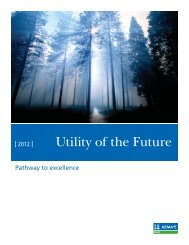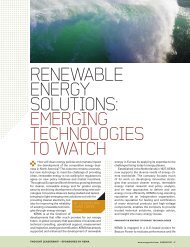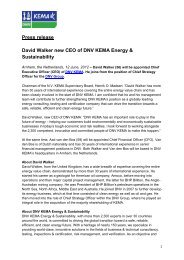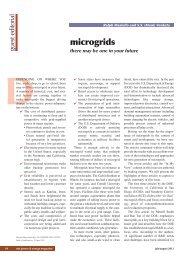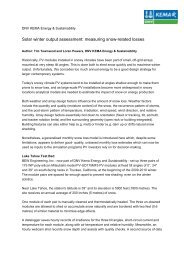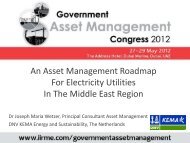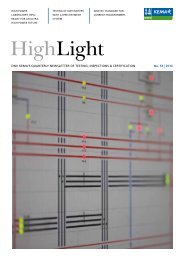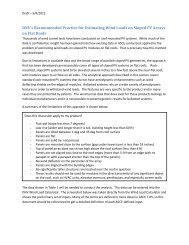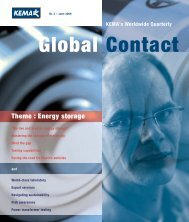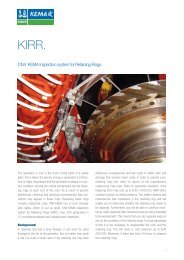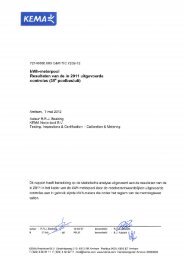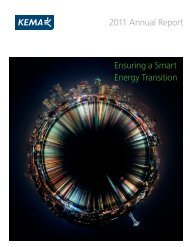Energy Storage Projects - DNV Kema
Energy Storage Projects - DNV Kema
Energy Storage Projects - DNV Kema
Create successful ePaper yourself
Turn your PDF publications into a flip-book with our unique Google optimized e-Paper software.
<strong>Energy</strong><br />
<strong>Storage</strong>
2<br />
Contents<br />
n <strong>Energy</strong> <strong>Storage</strong><br />
Selecting best-fit energy storage technologies 3<br />
Battery energy storage system for wind energy 5<br />
Power to Gas: methanation of hydrogen 7<br />
Zinc-Air flow batteries for power distribution networks 9<br />
Test facilities for energy storage systems 11<br />
Grid reliability and operability using flexible storage 13<br />
Modular electricity storage system 15
3<br />
Selecting best-fit energy<br />
storage technologies<br />
<strong>Energy</strong> <strong>Storage</strong> Select<br />
Many clients have come to <strong>DNV</strong> KEMA seeking a way to assess and choose the energy<br />
storage technology that best performs a specific application or set of applications at the<br />
best return on investment. Identifying the best storage technology for an application<br />
requires careful analysis of many interrelated factors. Few standards or test procedures are<br />
available to govern and help compare these devices. As such, many uncertainties surround<br />
these business and technical factors, which impact investment decisions.<br />
<strong>Energy</strong> storage technologies can vary widely from an electric battery to a flywheel to thermal<br />
units. As a result, operational characteristics, including deliverable power, efficiency,<br />
discharge time, and cycle life, differ across technologies. Business factors such as installed<br />
cost, the number of applications the device can be applied to, and the ability to monetize the<br />
intended benefits of the application, also add to the challenge of identifying a technology’s<br />
cost-benefit ratio and developing the business case for investment.
4<br />
Project<br />
<strong>DNV</strong> KEMA developed <strong>Energy</strong> <strong>Storage</strong> Select (ES-Select) as a sophisticated,<br />
decision-support tool for end users and developers. Launched in June 2011, ES-Select<br />
provides targeted, end-user defined analyses to help determine the return on investment of<br />
energy storage technologies for the desired application.<br />
ES-Select performs several core functions:<br />
n Maps available and emerging technologies, from compressed air energy storage to<br />
nickel-cadmium batteries and thermal storage<br />
n Allows a user to choose a storage technology for multiple simultaneous applications, like<br />
T&D upgrade deferral and area regulation, and considers the compatibility of<br />
simultaneous applications in assessing the combined value<br />
n Handles uncertainties in application value, storage cost, cycle life, efficiency, discharge<br />
duration, and other parameters<br />
n Uses MonteCarlo simulation to process and provide a graphical comparison of<br />
probabilistic distributions for cost, payback, and other characteristics<br />
n Offers presentation-ready reports for business case development, including charts and<br />
tables to compare financial and technical characteristics of energy storage technologies<br />
Objectives<br />
<strong>DNV</strong> KEMA created this tool to help users and developers manage the<br />
challenges and uncertainties in selecting feasible energy storage technology<br />
options.<br />
Benefits<br />
ES-Select is a highly interactive model, which provides evaluation ease. Users can change all<br />
recommended default values and add new storage technologies to the model database.<br />
With ES-Select, users can carefully analyze the interrelated factors that influence storage<br />
selection and the total cost of an energy storage system. It enables them to make more<br />
informed, confident investment decisions to market and/or deploy energy storage and<br />
progress to a smart energy future. The Sandia National Laboratories will soon offer ES-Select<br />
on the Sandia website.<br />
Project coordinator<br />
n <strong>DNV</strong> KEMA, United States<br />
Project details<br />
n Duration July 2010 – June 2011
5<br />
Battery energy storage<br />
system for wind energy<br />
First Wind - Hawaii<br />
First Wind is an independent company focused on the development, ownership and operation<br />
of wind energy projects. First Wind planned to install wind farms throughout the islands of<br />
Hawaii to produce clean, renewable power. However, the variable nature of renewable<br />
generation can lead to difficulty in maintaining electricity grid operations; this problem can<br />
become even more acute for island applications. Hence, the Hawaiian utilities established<br />
requirements that renewable project developers must meet to qualify for interconnection.<br />
First Wind had to meet requirements for ramp rates and potential power fluctuations, as<br />
stipulated in the Hawaiian Electric Company’s (HECO) model power purchase agreement, to<br />
interconnect a wind farm to the grid. First Wind examined the potential of integrating an<br />
advanced energy storage device, since it offered characteristics that would allow the wind<br />
farm to meet the requirements. First Wind targeted the Xtreme Power battery and sought<br />
assistance to help confirm its evaluation of the technology, performance, and operation of the<br />
battery storage system.
6<br />
Project<br />
<strong>DNV</strong> KEMA’s work targeted the evaluation of the proposed battery solution to support First<br />
Wind’s development on one of the Hawaiian Islands. <strong>DNV</strong> KEMA performed a series of tasks:<br />
n Conducted a technology evaluation of Xtreme Power’s battery device<br />
n Evaluated the proposed control algorithm that was being used to operate the battery<br />
n Confirmed the sizing analysis to determine the optimal size of the battery for the project<br />
n Reviewed factory acceptance test documents and observed actual testing at the battery<br />
manufacturer’s site<br />
n Confirmed the control algorithm’s ability to operate a 1MW-sized system at the First Wind<br />
test site, located at an operational wind farm in Maui<br />
Objectives<br />
Due to limited availability of product performance data given the pre-commercialized state of<br />
battery technologies, First Wind turned to <strong>DNV</strong> KEMA’s experts to help navigate it through<br />
the process of evaluating, selecting, and sizing the battery, so it could commission operation<br />
of the wind farm and meet requirements of HECO and project participants.<br />
Key results<br />
<strong>DNV</strong> KEMA’s work to support the development of a storage device enabled First Wind to<br />
meet HECO’s requirements for grid connection. By confirming the appropriate battery size,<br />
<strong>DNV</strong> KEMA helped First Wind to maximize wind energy storage capacity for the wind farm,<br />
which will ensure efficient energy production. This 30-MW wind farm began operating in<br />
March 2011. It is helping to decrease dependency on fossil fuels, thereby reducing<br />
greenhouse gas emissions that would be harmful to the environment.<br />
Client<br />
n First Wind, United States<br />
Project coordinator<br />
n <strong>DNV</strong> KEMA, United States<br />
Project partners<br />
n Xtreme Power, United States<br />
Project details<br />
n Duration: January 2009 – October 2009
7<br />
Power to Gas:<br />
methanation of hydrogen<br />
The intermittent character of sustainable energy technologies, such as solar and wind<br />
energy, affects the stability of the existing electricity infrastructure. As the installed capacity<br />
of intermittent energy sources increases, the need for flexibility in electricity accommodation<br />
and storage also increases. Interest has been expressed in the possible ways to use the gas<br />
infrastructure for electricity storage, in which Europe’s extended gas infrastructure would<br />
enable seasonal storage of electricity by the conversion of electricity into gas.<br />
<strong>DNV</strong> KEMA acknowledges the value of the gas infrastructure to store excess electricity in<br />
times of high production and low demand. By conversion of electricity into hydrogen (by<br />
electrolysis), and subsequently into methane (by methanation), large amounts of energy can<br />
be stored in the natural gas infrastructure. It enables electricity supply and demand<br />
matching, seasonal energy storage and the production of sustainable methane without<br />
dependence on biomass. It also enables CO 2<br />
recycling.
8<br />
Project<br />
In 2011 <strong>DNV</strong> KEMA started the development of a lab-scale methanation installation, in which<br />
hydrogen (H2) and carbon monoxide/dioxide (CO/CO 2<br />
) are converted into methane (CH4).<br />
This process is driven by the catalytic Sabatier reaction. In the first phase of the project, tests<br />
were performed with a nickel catalyst at temperatures of about 400°C – 500°C at ambient<br />
pressure.<br />
Further research will be performed with an optimized reactor with multiple methanation<br />
reactors. Also, the pressure will be varied and temperature profiles fine tuned.<br />
Objectives<br />
n Identification of methanation process parameters<br />
n Catalytic conversion of carbon dioxide and hydrogen into methane<br />
n Carbon dioxide recycling<br />
n Determination of catalyst performance<br />
n Gas analysis of product gas<br />
Project coordinator<br />
n <strong>DNV</strong> KEMA, the Netherlands<br />
Project details<br />
n Duration: 2011 – Ongoing
9<br />
Zinc-Air flow batteries for<br />
power distribution networks<br />
POWAIR<br />
Electricity storage systems could well be central to the future of our electricity supply.<br />
Looking ahead, we may expect decentralized power generation to play a bigger role and the<br />
volume of sustainable wind and solar energy to increase. The output from such power<br />
sources is hard to control or to match with the demand, and this has implications for the<br />
stability and quality of electricity networks.<br />
Several technologies for local, small-scale storage are currently available or under<br />
development. Conventional battery systems have a relatively short discharging time of about<br />
2 hours. For storing renewable energy overnight, flow battery systems, such as Zinc-Air flow<br />
batteries, are suitable since they can store relatively large amounts of energy and have low<br />
self-discharge rates.
10<br />
Objectives<br />
The project’s overall aim is to create a low-cost, modular and environmentally sustainable<br />
electrical energy storage system with high energy density and fast response. To achieve<br />
these aims, the project will radically extend the performance of zinc-air batteries from<br />
small-scale single primary cells to rechargeable redox flow battery modules, which at<br />
production scale can be stacked to give powers of 20 kW to several MW with several hours<br />
of storage.<br />
In tandem with the battery system, a novel distributed power converter will be developed to<br />
enable ‘plug and play’ scale-up and hot swapping of battery modules (i.e. disconnection,<br />
replacement and reconnection of a single battery performed without interrupting<br />
performance of the energy storage system).<br />
The electronics will also selectively load the battery modules to allow proactive balancing of<br />
the batteries in a string during charge/discharge cycling and prevent any string from being<br />
significantly limited by a single weak battery, as is the case with existing systems.<br />
Benefits<br />
The POWAIR technology allows large capacities of electrical energy to be stored indefinitely,<br />
to be transmitted or distributed as and when required. The battery system can be charged<br />
directly from the grid, for peak saving applications, or from renewable energy installations,<br />
providing stability to the grid and eliminating the need for fossil-fuel-powered peaking plants.<br />
Project coordinator<br />
n C-Tech Innovation Ltd., United Kingdom<br />
Project partners<br />
n C-Tech Innovation Ltd., United Kingdom<br />
n <strong>DNV</strong> KEMA, the Netherlands<br />
n CEST Kompetenzzentrum für Elektrochemische<br />
Oberflächentechnologie GmbH, Austria<br />
n University of Southampton USTN, United Kingdom<br />
Project details<br />
n EU Seventh Framework Program<br />
n Duration: November 2010 – November 2014<br />
n University of Seville FIUS-GTE, Spain<br />
n Green Power Technologies SL, Spain<br />
n E.ON Engineering Ltd., United Kingdom<br />
n Fumatech GmbH, Germany
11<br />
Test facilities for energy<br />
storage systems<br />
Matching the production of electricity to the fluctuating demand is complicated as more<br />
renewable sources come on line. Small-scale or large-scale electricity storage creates<br />
flexibility, thus allowing grid operation and market mechanisms to function effectively. Battery<br />
powered (PH)EVs, e-bikes, utility-scale and ‘behind-the-meter’ energy storage will be<br />
common place.<br />
Project<br />
Many of the energy storage applications do not have standardized tests. We help clients<br />
determine the types of tests that should be performed and the right approach in designing<br />
the actual tests for the devices and applications. <strong>DNV</strong> KEMA has a comprehensive range of<br />
test facilities in Europe and the United States, which enables traditional and new equipment<br />
to be qualified for permanent or flexible connection to the electricity grid. Our laboratories are<br />
equipped to perform tests at any voltage level, including tests for PV storage systems,
12<br />
inverters and charge controllers. On top of that, we use simulating software to assess ESSs<br />
for their specific applications.<br />
Benefits<br />
The successful introduction of any given system needs to ensure electrical and chemical<br />
safety of the technology and product. <strong>Storage</strong> is utilizing new and potentially hazardous<br />
materials and technologies. Impact, shock, short-circuit, and overcharge testing are often<br />
applied at the cell- or stack-size level. For the different energy storage systems and battery<br />
types, a number of standards exist for safety. Depending on the size, chemistry and<br />
application, one of the IEC or UL standards apply. <strong>DNV</strong> KEMA, both in Netherlands and the<br />
United States, has the capability to conduct AC and DC tests at different voltage levels<br />
(LV-MV-HV) .<br />
Performance tests typically examine how far a storage device can be pushed. This ultimately<br />
determines which technology option and application to choose. <strong>DNV</strong> KEMA helps analyze<br />
how wella storage device of thousands of individual cells is configured, engineered and<br />
managed.Tests generally can be done at the manufacturer level, focusing on rated capacity,<br />
cycletesting versus operating conditions, and efficiency.<br />
To provide insights into the performance of a complete system, <strong>DNV</strong> KEMA can perform a<br />
large variety of tests on any DC current energy source (storage system, PV, fuel cell, …).<br />
We offer performance testing and simulation of user profiles at different voltage and current<br />
levels. The DC cell and module test levels go up to 40 kW per testing circuit with current<br />
ranging from 0.05 to 400 Ampere, and voltage levels from 0 to 100 Volt DC. The Flex Power<br />
Grid Lab can go up to 1 MW(DC) or 2 MVAR(AC) of apparent power with voltage levels up to<br />
10 kV.<br />
<strong>DNV</strong> KEMA can also carry out field tests with its 2 MW AC field test facility. Our site<br />
acceptancetesting (SAT) solutions help ensure energy storage systems meet performance<br />
specificationsafter field installation. The increasing application and penetration of<br />
grid-connected batterysystems inevitably raises the demand for testing of the behavior of<br />
the equipment and itsinteraction with the power grid.<br />
Project coordinator<br />
n <strong>DNV</strong> KEMA, the Netherlands, United States<br />
Project details<br />
n Duration: 2008 – Ongoing
13<br />
Grid reliability and operability<br />
using flexible storage<br />
GROW-DERS<br />
Connecting newly developed sustainable, dispersed energy resources to the electricity<br />
distribution networks has significant implications for the management of these networks.<br />
Problems are liable to arise with stability, security, supply and demand peaks, and overall<br />
management.<br />
Many technical and economic issues associated with the large-scale introduction of<br />
distributed, sustainable energy sources can be solved by using electricity storage systems.<br />
However, end users are not showing much interest in the deployment of storage<br />
technologies. This can probably be attributed to a lack of familiarity with the technology, lack<br />
of confidence, and uncertainty about the costs and benefits. Moreover, network components<br />
are designed for a technical and economic service life of 40 years, and this also encourages<br />
conservatism.
14<br />
Project<br />
GROW-DERS offers a solution involving transportable and flexible storage based on newly<br />
developed power electronics. The project demonstrates the technical feasibility and<br />
economic viability of storage systems. At four sites, three different storage systems and a<br />
combination set-up have been demonstrated. The benefits of storage systems in these<br />
situations have been evaluated using a technical-economic assessment tool that<br />
incorporates intelligent prediction software. This software tool (called PLATOS) was<br />
developed within the GROW-DERS project and validated with the results of the field tests.<br />
Objectives<br />
The scientific and technological objectives of GROW-DERS are:<br />
n To realize a transportable, flexible storage system<br />
n To realize an assessment tool for optimum distribution-network management<br />
n To formulate a description of concept directions for the EU regulatory framework<br />
The consortium provided four different test sites for the project. Each of the storage systems<br />
was tested at a minimum of two different sites, thus providing proof that storage systems<br />
can be transported and operated in various locations. The project realized three<br />
transportable, flexible storage systems and demonstrated the technical benefits of these<br />
systems. Moreover, it realized an assessment tool for optimum distribution-network<br />
management (PLATOS), and completed a description of concept directions for the EU<br />
regulatory framework.<br />
Project coordinator<br />
n <strong>DNV</strong> KEMA, the Netherlands<br />
Project partners<br />
n Liander, the Netherlands<br />
n SAFT, France<br />
n IPE, Poland<br />
n EAC, Cyprus<br />
n Iberdrola, Spain<br />
n MVV, Germany<br />
n INES, France<br />
n Exendis, the Netherlands<br />
Project details<br />
n EU Sixth Framework Program<br />
n Duration: September 2007 – June 2011
15<br />
Modular electricity storage<br />
system<br />
Metal-air redox flow battery<br />
Electricity storage systems are an important element in enabling our electricity supply’s<br />
sustainable future. Looking ahead, we may expect decentralized power generation to play a<br />
bigger role and the volume of wind and solar energy to increase. The output from such<br />
renewable energy sources is hard to control or match with demand, and this has implications<br />
for the stability and quality of electricity networks. Several technologies for local, small-scale<br />
storage are currently available or under development. However, for large-scale systems<br />
(more than 100 MWh) the only feasible options today are pumped storage and compressed<br />
air energy storage (CEAS). Systems based on these technologies have a major geographical<br />
impact. For medium- to large-scale electricity storage, the redox flow battery is an attractive<br />
alternative.<br />
Redox flow storage units of the first and second generation need a reactor with an expensive<br />
membrane and two large vessels with electrolytes in an acidic environment. With all the
16<br />
controls and auxiliary equipment, the capital cost of such a system works out to about € 100<br />
per kWh.<br />
Objectives<br />
The objectives of this metal-air redox flow project are to find a way to use oxygen from the<br />
ambient air as the cathode-side reactant and to develop membranes that are easy and<br />
cost-effective to produce on a large scale. If these objectives are realized, the resulting<br />
third-generation redox flow systems should provide power at about € 50 per kWh – half the<br />
cost of the current systems.<br />
Project phases:<br />
n Technology survey<br />
n Membrane development<br />
n Development of the electrode and catalyst<br />
n Development of a membrane-electrode assembly<br />
n Integration of the separately developed components into one operational system<br />
n Management, communication and dissemination<br />
Benefits<br />
The use of electricity storage systems will enable more sustainable generating units to be<br />
integrated into the distribution network without compromising the quality of the electricity<br />
supply. Metal-air technology will decrease the volume and weight of redox flow batteries and<br />
reduce their cost, thereby making them a more viable option for medium to large-scale<br />
energy storage applications.<br />
Project coordinator<br />
n DVN KEMA, the Netherlands<br />
Project partners<br />
n University of Twente, European Membrane Institute (EMI), the Netherlands<br />
n MAGNETO Special Anodes, the Netherlands<br />
Project details<br />
n EOS-LT Program<br />
n Duration: January 2006 – December 2011




